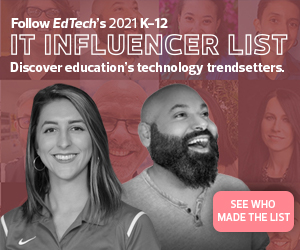EDTECH: What does it mean to curate student data?
SAMPSON: For the lay person out there, when they hear curation, they’re like, “Well, what is that? Are you working at a museum? What are you doing?” So no, it’s not working at a museum, but basically, it’s “portfolioing” your experience; that’s what curation is. It’s the ability to put together different pieces that are eclectic and unique to you versus a standardized approach where you have to put every square peg into square holes, every round peg into these round holes. And round pegs might not be your thing, but the standardized approach says you have to do it.
But what curation does is, it allows you to pick and choose your learning experience and your story and what’s important to you and curate it. You learn a heck of a lot from it, and you share it, and other people might look at it. The beauty of curation is the ability to tell your story as you see it, and then, obviously, you have to convince other people about your story.
INSIDER EXCLUSIVE: Discover 5 tips for effectively curating student data.
So, for instance, one of the schools that I work with in North Carolina is a blended learning high school that started up five or six years ago as a public charter school. We’ve built the K–12 model — started K–8, then it went to high school — and it was just announced that the high school is ranked by U.S. News & World Report as one of the top high schools in America. These are kids in rural North Carolina, outside of Raleigh, and their town, Wilson, N.C., was rated a couple years ago the worst small town in America. It’s an old tobacco town, so there are no jobs, no prospects. But we’ll take kids, wherever you come from, we’ll take you, and we’ll put you into the process for success.
EDTECH: What data should schools examine to find inequalities and achievement gaps?
SAMPSON: The standardized assessment data is a starting point. People typically think that standardized assessment data is the end point, when actually the standardized data is just the starting point. And what people don’t realize about standardized data is that it’s the absolute minimum that a kid is supposed to be able to know.
So, with that in mind, look at standardized data as the starting point and then curate the performance tests that schools are actually doing. What does the daily teaching moment look like, sound like and feel like? What is the experience that the kid is having in the school and outside of the school, with and without their learning? Now you can curate those processes, very simply, by using a few different digital tools. Now you have a holistic picture of the learning and the growth that’s occurring with that individual student or groups of students.
The simple part is to identify the gaps. At Westerville North High School, we downloaded all of the students and their demographics into our spreadsheet. And we looked at who was taking what courses, student ID numbers, the ethnicities and the genders, and we balanced it all out to see who was where. The easy part is to analyze the data. The hard part is, what are you going to actually do about it?
DISCOVER: K–12 schools build culture and community around data.
EDTECH: To that end, what corrective measures can schools take once they identify these gaps?
SAMPSON: You have look beyond who was enrolled in what courses and move into the concept of why. Move into the concept of the culture and looking at your cultures and the behavior of the students and adults. When I say behavior, I mean, how do we act toward each other? What are our expectations about each other? And what do we truly value as a school and as students?
At Westerville North High School, we figured out that nobody had ever asked the students of color, “Hey, I noticed that you’re doing really well in school. Why aren’t you taking an honors class next year?” We had an identifying marker in our spreadsheets that showed kids who were really smart in science, who elected to take the path of least resistance. When you’re a 15- or 16-year-old kid, you don’t want to work that hard. You want to hang out with your buddies. Once somebody challenged them, in a good way, that’s when the culture started to change.
Then, the same kids that I was talking to were talking to a kid, a freshman or sophomore, and they told him to show them his schedule for next year. And they told him that he was really smart, and he needed to be enrolled in advanced and honors-level courses. They wanted to see his schedule and double check that he was doing what he was supposed to do. So, the culture totally flipped upside down. The kids really own their culture of excellence. They’re self-monitoring in a good way.
Create a process that the kids absolutely fall in love with, because when they can see themselves being successful, and they can see the endgame, they’re going to actually max out their potential. Whatever they set their potential to be, whatever they want their career pathways to be, whatever they want their goals and aspirations to be, now it’s all self-directed.
MORE ON EDTECH: Is virtual learning here to stay for K–12 students?
EDTECH: Why is it important to take a holistic view of student data in today’s learning environment?
SAMPSON: Over the past 365 days, kids have been plugged into TikTok, plugged into Twitch, plugged into Instagram, plugged into news and plugged into global events. Now kids are coming back to school thinking, “In my mind, I’ve curated what a high school experience is supposed to be like. I’ve seen it unfold on TV. I’ve marched; I’ve set my life on the line.” And now we’re telling the kids to come back into this cookie-cutter, sterile environment, as if nothing happened, as if they are still this kid that left a year ago. We have to re-engage the kids and let them fall back in love with school and learning. Not that the reality of the world is not important, but they have to figure out, “How do I fit into and improve this reality of the world through the lens of education?”
Curated data should show students’ connection with the content and their connection with the academics. And then just make sure they have a purpose. When students can self-define their own purpose, I think they become free. That data becomes a gateway to their own freedom.
INSIDER EXCLUSIVE: Discover 5 tips for effectively curating student data.











